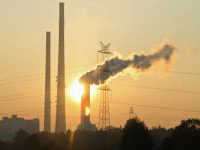Cleaning Up Clean Coal
 GLOBE-Net - Perhaps the only point that advocates for and against ’clean coal’ might agree on is the fact that we have lots of coal remaining and its continued use likely will be a significant part of our fossil fuel future.
GLOBE-Net - Perhaps the only point that advocates for and against ’clean coal’ might agree on is the fact that we have lots of coal remaining and its continued use likely will be a significant part of our fossil fuel future. Whether it should be the fuel of choice is another matter. The coal industry - acutely aware of growing public concern over greenhouse gas emissions and other health-related issues associated with continued use of coal - has launched major public relations campaigns to pitch ’clean coal’ as an environmentally friendly fuel.
Promoting ’clean coal technology’ was a major plank in both platforms in the 2008 U.S. presidential campaign and President-elect Obama is on record as supporting investing in “clean coal” technology.
However, former U.S. Vice President Al Gore who staunchly maintains that ’clean coal’ simply does not exist, has launched his own media counter-attack disputing industry claims that it does.
Oddly enough, both sides may be right.
No matter how you cut it, burning carbon-rich fossil fuels is anything but pollution free. But the mechanics of cleaning up the use of coal encompasses a variety of technologies and processes - some of which are well established and proven, such as washing coal or capturing emissions (mainly CO2).
But storing CO2 emissions is another story. The most effective technology for storing CO2 - carbon sequestration - is still 10-15 years from being built on any significant commercial scale, at least in North America. (See article North America’s Largest Carbon Sequestration Project Set to Go)
Clean coal supporters readily acknowledge that carbon sequestering technology is not market-ready. Joe Lucas, senior vice president for the American Coalition for Clean Coal Energy, a group of 48 coal companies and power plants that have spent heavily on the “clean coal” marketing campaign, is quoted in a Washington Times article as saying “There are all kinds of options we’re pursuing.”
“The industry is stepping up to help with carbon reduction, that includes educating the public about why investing in new technologies is very important,” Mr. Lucas said by way of explaining why so much is being spent on the advertising campaign.
Critics counter this by pointing to the relatively low level of private investment that is going into research and development for technologies that would clean up the fossil fuel industry relative to the profits that are being made annually by companies in the sector.
This point was driven home forcefully this week with the release of a major report (The Clean Coal Smoke Screen) by The Center for American Progress (CAP), a liberal think tank with deep ties to the incoming Obama administration.
It noted the rate of investment for carbon capture and storage (CCS) must increase dramatically if it is to play any significant role in greenhouse gas emission reductions from coal-fired power plants.
The Centre cites recent studies by the International Energy Agency that found current CCS spending and activity levels are nowhere near enough” to reduce emissions by 20 percent by 2020. Instead, the IEA advised that “up to USD 20 billion is needed for near-term demonstrations.”
(The Schwarze Pumpe coal power plant in eastern Germany is the world’s first coal-fired power plant to capture and store its own carbon dioxide emissions, a pilot project that began running in September 2008. See article World’s First Carbon Capture Pilot Fires Up Clean-Coal Advocates.)
Credit Suisse says that CCS research “needs a further $15 billion of investment and 10 more years of research and development to be ready for commercial use.” These levels are significantly more than the than the combined research effort of the ACCCE companies and Department of Energy.
The one clear message that one might take from the war of words about ’clean coal’ is that much more effort is required to actually clean up the use of coal as a primary fossil fuel.
Industry observers suspect the coal energy sector is looking forward to massive increases in public funding for basic research and demonstration projects. The expectation is not without some justification, as up front investments for commercial scale carbon sequestration facilities are massive, and few utilities - the primary users of coal - are capable of investments of that scale.
As noted by Frank Maisano, spokesman for the Electric Reliability Coordinating Council, a coalition of utilities and transportation companies, also quoted in the Washington Times article “the reality that coal is a major part of keeping the lights on in this country.”
That simple truth is likely going to be a major consideration of the Obama administration once it takes office.
You can return to the main Market News page, or press the Back button on your browser.

